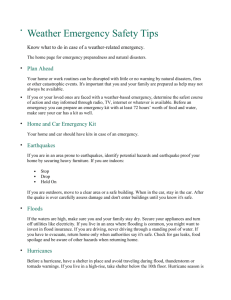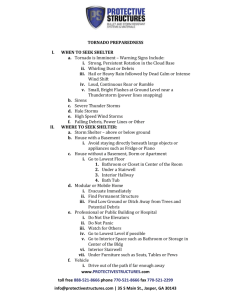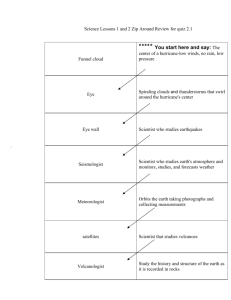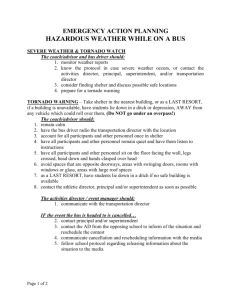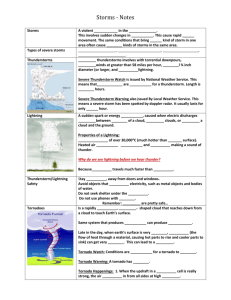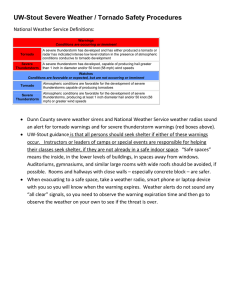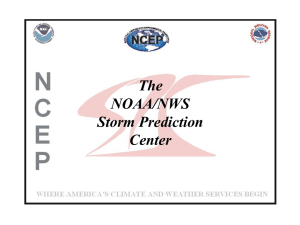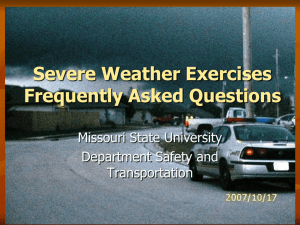File
advertisement
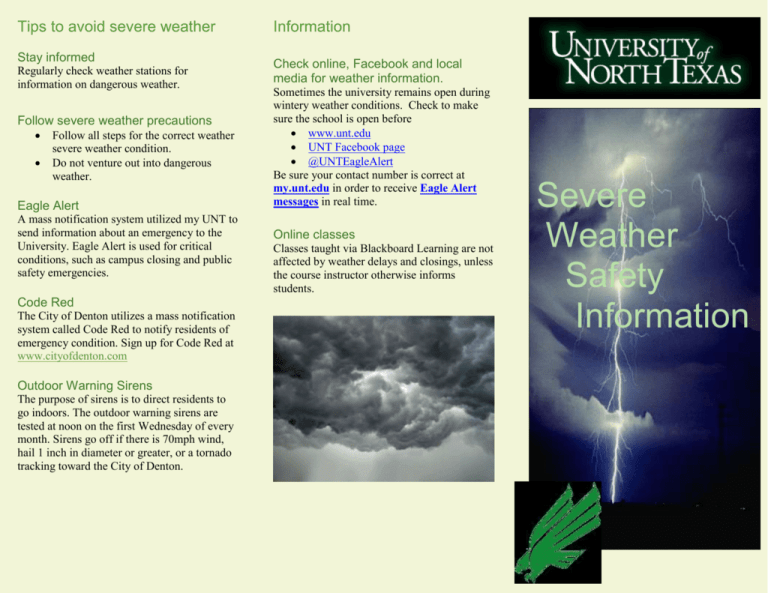
Tips to avoid severe weather Stay informed Regularly check weather stations for information on dangerous weather. Follow severe weather precautions Follow all steps for the correct weather severe weather condition. Do not venture out into dangerous weather. Eagle Alert A mass notification system utilized my UNT to send information about an emergency to the University. Eagle Alert is used for critical conditions, such as campus closing and public safety emergencies. Code Red The City of Denton utilizes a mass notification system called Code Red to notify residents of emergency condition. Sign up for Code Red at www.cityofdenton.com Outdoor Warning Sirens The purpose of sirens is to direct residents to go indoors. The outdoor warning sirens are tested at noon on the first Wednesday of every month. Sirens go off if there is 70mph wind, hail 1 inch in diameter or greater, or a tornado tracking toward the City of Denton. Information Check online, Facebook and local media for weather information. Sometimes the university remains open during wintery weather conditions. Check to make sure the school is open before www.unt.edu UNT Facebook page @UNTEagleAlert Be sure your contact number is correct at my.unt.edu in order to receive Eagle Alert messages in real time. Online classes Classes taught via Blackboard Learning are not affected by weather delays and closings, unless the course instructor otherwise informs students. Severe Weather Safety Information Temperature Change Severe Thunderstorms Tornadoes Extreme temperatures are considered to be above 100ᵒF and below 0ᵒF. Storms Tornadoes are violent storms, which cause destruction. The important thing to keep in mind during a tornado is to take shelter. Typically occurs in warm, moist air masses and fronts, like Denton, Texas. A severe thunderstorm is defined by the National Weather Service as a storm that produces either hail greater than one inch or winds 58mph or higher. How do storms occur? In case of high temperatures Exposure to high temperatures can easily cause heat stroke and dehydration. Follow these steps to avoid these ailments: Increase consumption of water to avoid dehydration. Wear sunscreen to avoid skin damage Stay indoors as much as possible to limit exposure to harmful sun rays. In case of freezing weather Prolonged exposure to extreme cold can cause hypothermia and frostbite as well as hazardous driving conditions. Follow these steps to stay safe: Make sure to wear warm, insulated clothing. Avoid prolonged time spent outside Avoid driving as much as possible. Rapid upward movement of warm, moist air. As air cools, it condenses, and forms cumulonimbus clouds. The air then reaches the point where water drops and ice form within the mass and fall. These small drops combine with other drops and become larger, forming the drops we recognize, before reaching the ground. The falling drops cause a downdraft of cold air and moisture that disperses producing wind and fog. What to know? What to know? Severe Thunderstorm Watch: A severe thunderstorm is possible. Severe Thunderstorm Warning: A severe thunderstorm is occurring. Tornado Watch: There is a possibility of a tornado. Tornado Warning: There is a tornado in sight. Take shelter. Where to take shelter? Tornadoes can occur at any time, regardless of where you are, so you need to know where to go, go to emergency.unt.edu website under “Shelter and Evacuation Maps.” In a small building: Go to a basement or a room in the lowest level of the building. Stay away from places with windows. In a vehicle: Get out of your vehicle immediately and seek shelter. The ideal location is on the lowest floor of a structure, away from windows, and with many walls as possible between the exterior of the exterior of the structure and the shelter area.
